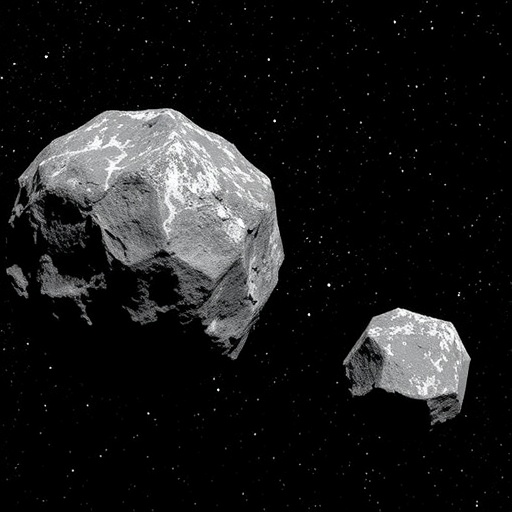A recent study conducted by scientists at the Southwest Research Institute (SwRI) has provided significant insights into the origins of two near-Earth asteroids, Bennu and Ryugu. The research presents compelling evidence suggesting that these asteroids may have originated from a common progenitor, known as the Polana collisional family, located in the main asteroid belt between Mars and Jupiter. This groundbreaking analysis stems from a comparative examination of spectral data obtained from these celestial bodies, using advanced technologies such as the James Webb Space Telescope (JWST).
Asteroids are remnants from the early solar system, offering vital clues about the formation and evolution of our planetary neighborhood. Bennu and Ryugu, both classified as near-Earth asteroids, have become focal points of study due to their intriguing characteristics and potential insights into the solar system’s history. While they traverse the same orbital region, researchers have always wondered whether these two asteroids could share a deeper connection, possibly stemming from a larger parent body.
Dr. Anicia Arredondo, the lead author of the SwRI study, emphasizes the significance of their findings: “We believe large asteroids collided early in the solar system’s history, leading to the creation of an ‘asteroid family.’ Polana is recognized as the largest remnant of that collision.” The study meticulously compared spectroscopy data from Polana and found strong correlations with material samples analyzed from Bennu and Ryugu. These similarities in spectral signatures bolster the hypothesis of a shared origin, a theory that transforms our understanding of these intriguing celestial objects.
To conduct this comprehensive analysis, the research team sought time on the JWST, a state-of-the-art observatory capable of capturing detailed spectral data across different wavelengths. By employing two distinct spectral instruments, the researchers focused their efforts on Polana’s near-infrared and mid-infrared wavelengths. They then juxtaposed this data against the physical samples of Ryugu and Bennu, which were collected during separate space missions. The Hayabusa2 mission, organized by the Japan Aerospace Exploration Agency, successfully collected samples from Ryugu in 2018, returning them to Earth in late 2020. In contrast, NASA’s OSIRIS-REx spacecraft encountered Bennu in 2020, with its samples arriving back on Earth in late 2023.
The implications of this study stretch far beyond the mere identification of spectral similarities. Bennu and Ryugu, while classified as near-Earth asteroids and sharing similar orbital paths, exhibit distinct characteristics influenced by their journeys through the solar system. Each body has experienced various environmental factors, including solar radiation and the impacts of micrometeoroids, which can fundamentally alter their surface composition and properties over time.
Interestingly, despite the observed variances in their spectral data, the differences were not sufficient to rule out the hypothesis of a common ancestry. Dr. Tracy Becker, a co-author of the study, elaborates on this, stating, “The spectral evidence suggests that while Polana, Bennu, and Ryugu have undergone individual transformations, the underlying chemistry connecting them remains. The journey of each asteroid through the solar system has shaped its current characteristics.”
As their study unfolds, the researchers recognize that the gravitational influence of Jupiter may have played a critical role in the evolutionary history of Bennu and Ryugu. It is theorized that interactions with Jupiter’s immense gravity led to the ejection of these asteroids from their original orbits, ultimately placing them closer to the Sun. Such movements allowed for important chemical reactions and transformations to occur in the materials constituting these celestial bodies.
The scientific community has long been intrigued by the dynamics of asteroid families and their potential connections to the early solar system’s chaos. Data revealing that Bennu, Ryugu, and Polana share a common origin helps elucidate the complex interplay of collisions and gravitational interactions that shaped the current asteroid belt. Moreover, understanding this interrelationship can enhance our knowledge about asteroid potentialities, including the risks posed by near-Earth bodies and their potential for resource mining in the future.
As the findings of this study are prepared for publication in the prestigious Planetary Science Journal, the research team reflects on the broader contexts of their work. With the continual advancement of observational technologies like the JWST, researchers are now equipped to uncover deeper insights into the histories of celestial bodies that were previously obscured. The intersection of advanced spectroscopy and comparative analysis serves as a powerful tool in the quest to unravel the mysteries of our solar system.
In conclusion, the insights provided by the SwRI’s study of Bennu, Ryugu, and Polana usher in a new era in asteroid research. These findings not only highlight the value of international collaboration in space missions but also underscore the importance of interdisciplinary methodologies in advancing our scientific understanding. As researchers continue to analyze these asteroids, they pave the way for future explorations that will further enhance our knowledge of the origins of our solar system and the evolutionary paths taken by its many inhabitants.
Subject of Research: Near-Earth Asteroids
Article Title: JWST spectroscopy of (142) Polana: Connection to NEAs (101955) Bennu and (162173) Ryugu
News Publication Date: August 18, 2025
Web References: SWRI Planetary Science
References: DOI: 10.3847/PSJ/ade395
Image Credits: Credit: NASA
Keywords
asteroid family, spectroscopy, near-Earth asteroids, Polana, Bennu, Ryugu, solar system formation, JWST, gravitational interactions, celestial bodies, space missions, Southwest Research Institute, planetary science




